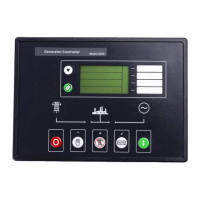55xGenComm1_29 www.wellfut.com 0755-27153030 0755-27732300
9
General Definitions and Requirements of GenComm
1. A single piece of generating set control equipment is referred to as a ‘control unit’ or ‘control
module’.
2. A control unit is always a slave device as defined in the Modbus protocol.
3. A PC, building management system or similar system is referred to as a ‘master device’ as
defined in the Modbus protocol.
4. A hub is a device that connects a master device to one or more control units, to a master it
appears as a slave and to a control unit it appears as a master.
5. A control unit connected to a hub is referred to as a satellite device of the hub.
6. The term ‘slave device’ refers either to a control unit or to a hub when it is viewed from a
master’s point of view.
7. The transmission mode used by GenComm is ModBus RTU not ( ModBus ASCII).
8. The byte format over an RS485 link shall be 1 start bit, 8 data bits, no parity bit and 2 stop bits
as defined by the Modbus protocol.
9. The byte format over an RS232 link to a modem or direct to a PC shall be 1 start bit, 8 data
bits, no parity bit and 1 stop bit which is the de-facto standard for modems.
10. The baud rate used will be one of those listed in GenComm Page 1 - Communications Settings.
11. Bus time-outs must be detected by the master, as defined in the Modbus protocol.
12. For details of the Unicode character representation refer to the Unicode standard version 2.0
published by the Unicode Consortium.
13. Unicode strings may contain the control code 0x000D which shall be interpreted as “move to
the beginning of the next line down” (commonly called Carriage return and Newline).
14. Any software that reads a Unicode string may either use the control code 0x000A to split the
string into separate lines or may replace it with 0x0020 if it is desired to display the string on a
single line. It must not be ignored as this may lead to the concatenation of words.
15. In this standard the term ‘ASCII character’ refers to an 8 bit character following the sub-set of
Unicode from 0 to 255, it does not refer to any other published standard of character
representation to avoid the ambiguities in such standards.
16. This document describes GenComm version 1.xx, future upgrades of this standard will
increase this version number by 1 and must be fully backwards compatible with all previous
versions.
17. Any software written to interface with a GenComm version n slave device will be able to
interface with a GenComm version n+1, n+2 etc. slave device without modification, and will be
able to perform any operation defined in version n, but will not, of course, be able to perform
functions added in later versions.
18. Any software written to interface with a GenComm version n slave devices will recognise a
GenComm version n-1 slave device (from the ‘Communications Status Information’ page) and
perform all operations defined in version n-1 on that slave device, it will not attempt to perform
any operations added in later versions of GenComm on that slave device.
Multiple Masters
GenComm is based on Modbus, which is a protocol that is only intended for a simple single master
network, therefore it does not support multiple masters accessing a slave simultaneously.
If a slave device has more than one interface that can act as a master, it must only serve one
master at once. Whenever it changes masters it must completely re-initialise the status of the port,
in particular it must clear the password status to 0 (Invalid) and the extended exception information
to 0 (No error), thus ensuring that there can be no interaction between masters of any kind. Any
master that makes a query while its port is not being served must either be answered by exception
6 (Slave device busy) whatever the query was, or not answered at all.
GenComm does not support multiple communications configurations for multiple master ports.

